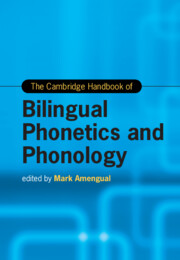Book contents
- The Cambridge Handbook of Bilingual Phonetics and Phonology
- Cambridge Handbooks in Language and Linguistics
- The Cambridge Handbook of Bilingual Phonetics and Phonology
- Copyright page
- Dedication
- Contents
- Figures
- Tables
- Contributors
- Acknowledgments
- Introduction Bilingual Phonetics and Phonology
- Part I Approaches to Bilingual Phonetics and Phonology
- Part II Theoretical Models of Bilingual Phonetics and Phonology
- Part III The Phonetics and Phonology of the Bilingual Child
- Part IV The Phonetics and Phonology of the Bilingual Adult
- Part V The Diversity of Bilingual Speakers
- 22 The Phonetics and Phonology of Early Bilinguals
- 23 The Phonetics and Phonology of Adult L2 Learners in the Classroom
- 24 The Phonetics and Phonology of Adult L2 Learners After Study Abroad
- 25 The Phonetics and Phonology of Heritage Language Speakers
- 26 The Phonetics and Phonology of Indigenous Language Bilinguals
- 27 The Phonology of Bimodal Bilinguals
- 28 Comparing Bilingual and Trilingual Phonetics and Phonology
- Part VI Variables and Outcomes of Bilingual Speech
- Index
- References
23 - The Phonetics and Phonology of Adult L2 Learners in the Classroom
from Part V - The Diversity of Bilingual Speakers
Published online by Cambridge University Press: 14 November 2024
- The Cambridge Handbook of Bilingual Phonetics and Phonology
- Cambridge Handbooks in Language and Linguistics
- The Cambridge Handbook of Bilingual Phonetics and Phonology
- Copyright page
- Dedication
- Contents
- Figures
- Tables
- Contributors
- Acknowledgments
- Introduction Bilingual Phonetics and Phonology
- Part I Approaches to Bilingual Phonetics and Phonology
- Part II Theoretical Models of Bilingual Phonetics and Phonology
- Part III The Phonetics and Phonology of the Bilingual Child
- Part IV The Phonetics and Phonology of the Bilingual Adult
- Part V The Diversity of Bilingual Speakers
- 22 The Phonetics and Phonology of Early Bilinguals
- 23 The Phonetics and Phonology of Adult L2 Learners in the Classroom
- 24 The Phonetics and Phonology of Adult L2 Learners After Study Abroad
- 25 The Phonetics and Phonology of Heritage Language Speakers
- 26 The Phonetics and Phonology of Indigenous Language Bilinguals
- 27 The Phonology of Bimodal Bilinguals
- 28 Comparing Bilingual and Trilingual Phonetics and Phonology
- Part VI Variables and Outcomes of Bilingual Speech
- Index
- References
Summary
The chapter presents an overview of current and recent research concerning the phonetics and phonology of adult second language (L2) learners in classroom settings, summarizing key findings and suggesting future research directions. In this context, classroom learners are defined as college-age individuals who are immersed in their first language (L1) and whose L2 learning is limited to the instructional environment of college or university classes. The survey deliberately prioritizes studies that utilize instrumental acoustic analysis or controlled perceptual experiments to assess the phonetic and phonological abilities of L2 learners. Although not aiming for an exhaustive review, the chapter explores the following major themes in the surveyed research literature: the role of L2 input quantity and quality, the influence of different phonological targets, the impact of explicit pronunciation instruction and corrective feedback, the extent and implications of individual differences, and the significance of L2 phonetic category formation and L1 restructuring in the classroom-based acquisition of L2 phonetics and phonology.
Keywords
- Type
- Chapter
- Information
- The Cambridge Handbook of Bilingual Phonetics and Phonology , pp. 521 - 541Publisher: Cambridge University PressPrint publication year: 2024

